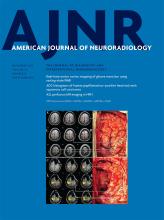Index by author
Pinel, A.
- LetterYou have accessOpen Globe Injury: Ultrasound First!A. Lecler, A. Pinel and P. KoskasAmerican Journal of Neuroradiology November 2017, 38 (11) E99-E100; DOI: https://doi.org/10.3174/ajnr.A5282
Pippin, K.J.
- Head and Neck ImagingYou have accessPrevalence of Internal Auditory Canal Diverticulum and Its Association with Hearing Loss and OtosclerosisK.J. Pippin, T.J. Muelleman, J. Hill, J. Leever, H. Staecker and L.N. LedbetterAmerican Journal of Neuroradiology November 2017, 38 (11) 2167-2171; DOI: https://doi.org/10.3174/ajnr.A5399
Polat, A.
- Pediatric NeuroimagingYou have accessVolume of Structures in the Fetal Brain Measured with a New Semiautomated MethodR. Ber, D. Hoffman, C. Hoffman, A. Polat, E. Derazne, A. Mayer and E. KatorzaAmerican Journal of Neuroradiology November 2017, 38 (11) 2193-2198; DOI: https://doi.org/10.3174/ajnr.A5349
Prieto, R.
- Adult BrainYou have accessTopographic Diagnosis of Craniopharyngiomas: The Accuracy of MRI Findings Observed on Conventional T1 and T2 ImagesR. Prieto, J.M. Pascual and L. BarriosAmerican Journal of Neuroradiology November 2017, 38 (11) 2073-2080; DOI: https://doi.org/10.3174/ajnr.A5361
Pritz, M.B.
- EDITOR'S CHOICENeurointerventionOpen AccessAngioarchitectures and Hemodynamic Characteristics of Posterior Communicating Artery Aneurysms and Their Association with Rupture StatusB.J. Chung, R. Doddasomayajula, F. Mut, F. Detmer, M.B. Pritz, F. Hamzei-Sichani, W. Brinjikji, D.F. Kallmes, C.M. Jimenez, C.M. Putman and J.R. CebralAmerican Journal of Neuroradiology November 2017, 38 (11) 2111-2118; DOI: https://doi.org/10.3174/ajnr.A5358
The authors studied 313 posterior communicating artery aneurysms (145 ruptured, 168 unruptured) with image-based computational fluid dynamics. Aneurysms were classified into different angioarchitecture types depending on the location of the aneurysm with respect to parent artery bifurcation. Ruptured aneurysms had higher, more concentrated, and more oscillatory wall shear stress distributions; stronger and more concentrated inflow jets; and more complex and unstable flow patterns compared with unruptured aneurysms. They conclude that high-flow intrasaccular hemodynamic characteristics, commonly found in bifurcation-type angioarchitectures, are associated with the posterior communicating artery aneurysm rupture status.
Purcell, Y.M.
- Head and Neck ImagingYou have accessThe Diagnostic Accuracy of Contrast-Enhanced CT of the Neck for the Investigation of SialolithiasisY.M. Purcell, R.G. Kavanagh, A.M. Cahalane, A.G. Carroll, S.G. Khoo and R.P. KilleenAmerican Journal of Neuroradiology November 2017, 38 (11) 2161-2166; DOI: https://doi.org/10.3174/ajnr.A5353
Pusztaszeri, M.
- FELLOWS' JOURNAL CLUBHead and Neck ImagingOpen AccessApparent Diffusion Coefficient Histograms of Human Papillomavirus–Positive and Human Papillomavirus–Negative Head and Neck Squamous Cell Carcinoma: Assessment of Tumor Heterogeneity and Comparison with HistopathologyT. de Perrot, V. Lenoir, M. Domingo Ayllón, N. Dulguerov, M. Pusztaszeri and M. BeckerAmerican Journal of Neuroradiology November 2017, 38 (11) 2153-2160; DOI: https://doi.org/10.3174/ajnr.A5370
One hundred five consecutive patients with primary oropharyngeal and oral cavity head and neck squamous cell carcinoma underwent MR imaging with anatomic and DWI sequences. The collected tumor voxels from the contoured ROIs provided histograms from which position, dispersion, and form parameters were computed. Histogram data were correlated with histopathology, p16-immunohistochemistry, and polymerase chain reaction for human papillomavirus DNA. Diffusion phenotypes of human papillomavirus–positive and human papillomavirus–negative head and neck squamous cell carcinomas showed significant differences, which reflect their distinct degree of tumor heterogeneity.
Putman, C.M.
- EDITOR'S CHOICENeurointerventionOpen AccessAngioarchitectures and Hemodynamic Characteristics of Posterior Communicating Artery Aneurysms and Their Association with Rupture StatusB.J. Chung, R. Doddasomayajula, F. Mut, F. Detmer, M.B. Pritz, F. Hamzei-Sichani, W. Brinjikji, D.F. Kallmes, C.M. Jimenez, C.M. Putman and J.R. CebralAmerican Journal of Neuroradiology November 2017, 38 (11) 2111-2118; DOI: https://doi.org/10.3174/ajnr.A5358
The authors studied 313 posterior communicating artery aneurysms (145 ruptured, 168 unruptured) with image-based computational fluid dynamics. Aneurysms were classified into different angioarchitecture types depending on the location of the aneurysm with respect to parent artery bifurcation. Ruptured aneurysms had higher, more concentrated, and more oscillatory wall shear stress distributions; stronger and more concentrated inflow jets; and more complex and unstable flow patterns compared with unruptured aneurysms. They conclude that high-flow intrasaccular hemodynamic characteristics, commonly found in bifurcation-type angioarchitectures, are associated with the posterior communicating artery aneurysm rupture status.
Qiu, D.
- EDITOR'S CHOICEAdult BrainOpen AccessThe Brain Thermal Response as a Potential Neuroimaging Biomarker of Cerebrovascular ImpairmentC.C. Fleischer, J. Wu, D. Qiu, S.-E. Park, F. Nahab and S. DehkharghaniAmerican Journal of Neuroradiology November 2017, 38 (11) 2044-2051; DOI: https://doi.org/10.3174/ajnr.A5380
The authors evaluated the use of noninvasive MR thermometry in patients with cerebrovascular disease, and hypothesized that the presence of a measurable brain thermalresponse would reflect the tissue hemodynamic state. MR imaging and MR thermometry were performed in 10 patients undergoing acetazolamide challenge for chronic, anterior circulation steno-occlusive disease. Cerebrovascular reactivity was calculated with BOLD imaging and arterial spin-labeling methods. Brain temperature was calculated pre- and post-acetazolamide using previously established chemical shift thermometry. They observed significant, voxelwise quadratic relationships between cerebrovascular reactivity from BOLD imaging and the brain thermal response and baseline brain temperatures, concluding that brain thermal response is a potential noninvasive biomarker for cerebrovascular impairment.
Qiu, T.-m.
- EDITOR'S CHOICEFunctionalOpen AccessReal-Time Motor Cortex Mapping for the Safe Resection of Glioma: An Intraoperative Resting-State fMRI StudyT.-m. Qiu, F.-y. Gong, X. Gong, J.-s. Wu, C.-p. Lin, B.B. Biswal, D.-x. Zhuang, C.-j. Yao, X.-l. Zhang, J.-f. Lu, F.-p. Zhu, Y. Mao and L.-f. ZhouAmerican Journal of Neuroradiology November 2017, 38 (11) 2146-2152; DOI: https://doi.org/10.3174/ajnr.A5369
The authors conducted preoperative and intraoperative resting-state intrinsic functional connectivity analyses of the motor cortex in 30 patients with brain tumors. Factors that may influence intraoperative imaging quality, including anesthesia type and tumor cavity, were studied. Additionally, direct cortical stimulation was used to validate the accuracy of intraoperative resting-state fMRI in mapping the motor cortex. Fourteen patients who successfully completed both sufficient intraoperative resting-state fMRI and direct cortical stimulation were used for further analysis of sensitivity and specificity. Compared with those subjected to direct cortical stimulation, the sensitivity and specificity of intraoperative resting-state fMRI in localizing the motor area were 61.7% and 93.7%, respectively. They conclude that using intraoperative resting-state fMRI can avoid the risk of intraoperative seizures due to direct cortical stimulation and may provide neurosurgeons with valuable information to facilitate the safe resection of gliomas.








